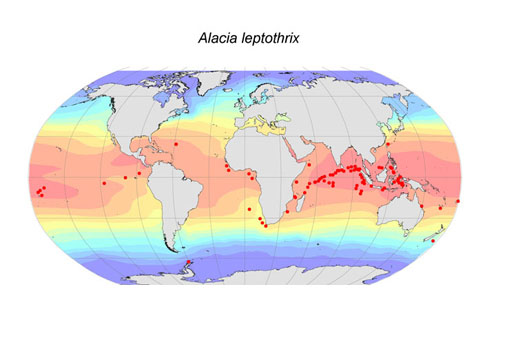Atlas of Atlantic Ostracods
Taxon details
Alacia leptothrix (Müller, G.W., 1906)
- Order:
- MYODOCOPA
- Suborder:
- Halocypridina
- Family:
- Halocyprididae
- Subfamily:
- Conchoecinae
- Size range (females):
- 3.1-3.4 mm
- Size range (males):
- 2.8-3.1 mm
- Depth:
- meso-/bathypelagic
Notes
85 records
The majority of records of this species are from low latitudes in the Indian Ocean and Indonesian Sea, in samples from mesopelagic depths. There are a few records from low latitudes in the Atlantic, mostly from samples that reached deep bathypelagic horizons. It is possible that when examined critically the Atlantic specimens may prove to be different from those from the Indian Ocean. Only two of Müller’s (1906) 17 records were from the Atlantic, both in Guinea Current region, but he failed to designate a type locality, an arbitrary choice may need to be taken as to which is considered to be typical. Poulsen (1969) also reported it at a single station in the Gulf of Guinea. In the Banda Sea it is one of the numerically dominant halocyprids, where its mean size is slightly larger than Poulsen’s (1973) specimens. Müller (1906)tentatively attributed this species to his “alata group”on the basis of the presence of lateral glands along the posterior margins of the two carapace valves, which he considered to be diagnostic for the genus. However, it has very few other characters in common with what we consider to be the type species for the genus alata. So when the genus is revised we expect this species will be classified in new genus.
| Poulsen Data | n | mean | s.d. | range |
|---|---|---|---|---|
| Female | 279 | 3.15 | 0.10 | 2.85-3.45 |
| Male | 114 | 2.82 | 0.09 | 2.63-3.08 |
| A-1 |
| Banda Sea | n | mean | s.d. | range |
|---|---|---|---|---|
| Female | 39 | 3.34 | 0.062 | 3.04-3.32 |
| Male | 105 | 2.93 | 0.054 | 2.80-3.12 |
| A-1 | 23 | 2.22 | 0.073 | 2.04-2.32 |
| A-2 |




